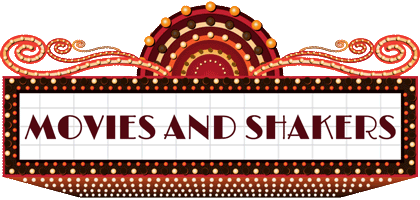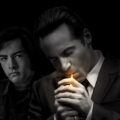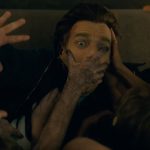
The contrast in the acting styles of Pacino, De Niro and Pesci are predictable, yet gripping in this mob drama. Director Martin Scorsese is in his element directing this finely tuned 3 and a half hour lavish production. Even at this bloated length, it didn’t become belabored until the last hour. The film starts with an impressive long follow shot through the corridors of a nursing home introducing us to the aged Frank Sheeran and proceeds as a series of flashbacks. It’s all about power, politics of the Mob and the Teamsters Union in the ’50’s to the ’70’s.
Pacino’s Hoffa is completely over the top, screaming, fuming, and fully engaged in rage. Compare that to Pesci and De Niro who rarely raise their voices. They know how to keep their emotions in check, yet they are seething under the surface. It’s great to see Pesci back after a 9-year hiatus. Pesci’s almost whispered instructions to carry out life and death orders are more than disconcerting. De Niro’s face is mostly a blank page until he has to kill the one man he cares most about. Seeing that pain etched on his face was the most touching moment in the film.
The film is historical fiction. It takes poetic license adapting the biography of hit man, Frank Sheeran (De Niro), in I Heard You Paint Houses, by Charles Brandt. The title is a euphemism for being a killer. Sheerhan admits stealing, lying and cheating to gain the trust and then friendship of Teamsters Union Head, Jimmy Hoffa (Al Pacino). And then confessed to killing him. Sheeran lived by the code the Don, Russell Bufalino (Joe Pesci) set to wield great power and protect his territory. The Teamsters had immense power over the trucking industry and their pension fund was the golden egg the Mob was after.
This is the most expensive film Scorsese has made to date, costing over $200 million. The cost ballooned paying for all of the special effects used to de-age his stars to look 30 years younger for most of the film. Was it worth it? For the overall effect, yes. But, in the beginning of the film, the stars as their younger characters look kind of cheesy. The special effects get better as they story progresses through the years.
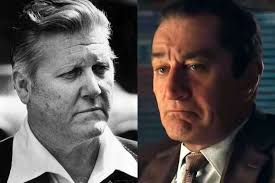
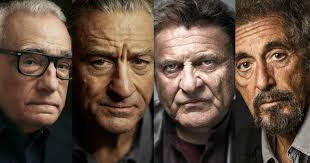
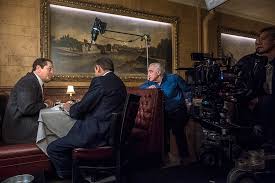
The film is a treatise that is detailed to the max. The cars are vintage snazzy, the clothes are polyester pastels, and the restaurants where they eat incessantly are elegant old Italian with red leather booths where the mobsters were waited on hand and foot.
Scorsese and writer Steve Zaillian (American Gangster, The Girl with the Dragon Tattoo, Schindler’s List) give the actors the phrases and pauses that make their interaction all that more measured and believable. There is minimal dialogue when Russell, Frank and Hoffa talk to each other. Gestures, furrowed eyebrows and head pointing are a signal for what these bosses want done. Most of the shots are static medium or close-ups of people talking to each other. Scorsese borrows some of the classic techniques of other gangster movies, including newspaper headlines and captions over still frames of mobsters as they get bumped off.
That’s also noticeable when Frank, Russell and their wives are taking a car trip to Detroit, following a route drawn on a map to stop for collections along the way. The wives in the back seat only seem to talk when they want to stop for a smoke or a bathroom break. Women are always take a back seat with these guys in this film.
The Teamsters had a lot of power and were every bit as corrupt and in bed with the mob. They were definitely violent, but not particularly bloody in the way they got rid of those who didn’t go along with their program. It was clean murder, in a way. Their MO was usually shooting someone in the head at close range, then throwing the weapon away. In the scene where Frank throws the gun in the river after a hit, he says there are enough guns down there to arm a small country, which got a laugh.
Sheeran climbs up the ladder ingratiating himself first to Gangland Royalty Russell Bufalino (Joe Pesci) and then to Hoffa who was mad with power. Pacino talks tough and acts tough, even though he is quite a bit shorter and less imposing a figure than real Teamster boss Hoffa. Scorsese tries to make him human showing how he doted over one of Sheeran’s daughters, Peggy (Anna Paquin). She hated her own father. Peggy saw him for what he was. Hoffa was nicer to her frequently taking her for ice cream. Seeing Pacino as Hoffa go crazy for ice cream lightens things up periodically.
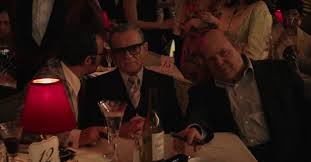
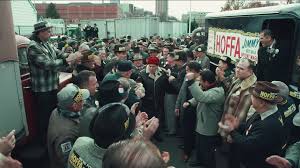
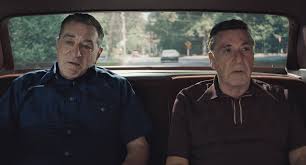
But Scorsese really showcases the power of these men in big scenes with a cast of thousands at a meeting of the Teamsters. There, Pacino, takes the reins and in a smoky grand ballroom surrounded by his faithful followers. And he does it again at a tense dinner to honor Frank in another display of power. Frank has now become a President of a Teamsters local. When Hoffa went to prison for 4 years his former “friends” pushed him aside and got cozy with the Mob. They had no use for Hoffa who wanted to take back control of the pension fund. Jimmy never stopped plotting his comeback to regain control of the Teamsters.
Scorsese uses the historical backdrop of the times, including the influence peddling of Joe Kennedy,crime busting Attorney General Bobby Kennedy, the assassination of JFK, and the Bay of Pigs fiasco that affected the Teamsters and the Mob.
To this day, Hoffa’s body has not been found. But Scorsese creates chilling scenes showing Frank torn between his allegiance to Bufalino or Hoffa being forced to kill him and how the body disappeared without a trace.
Scorsese scores big putting three of the biggest known actors together in a lavishly produced crime drama that will stand alongside Good Fellas and Casino. This will also become another Scorsese crime classic where De Niro, Pesci and Pacino each get their own space to show their own unique brand. Don’t take this as a history lesson. It’s Frank’s take on what happened to Hoffa. Scorsese and his cast created a helluva movie, whether it’s true or not.
Netflix 3 hours 29 minutes R
